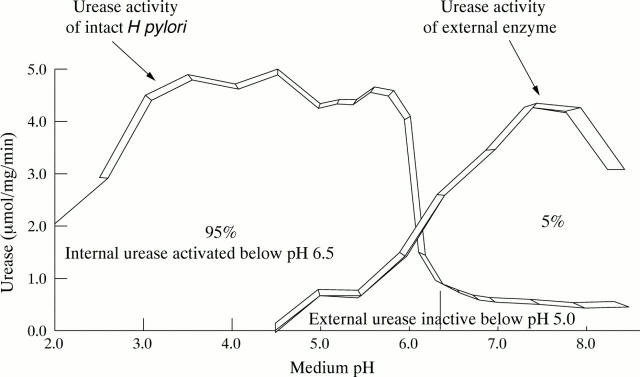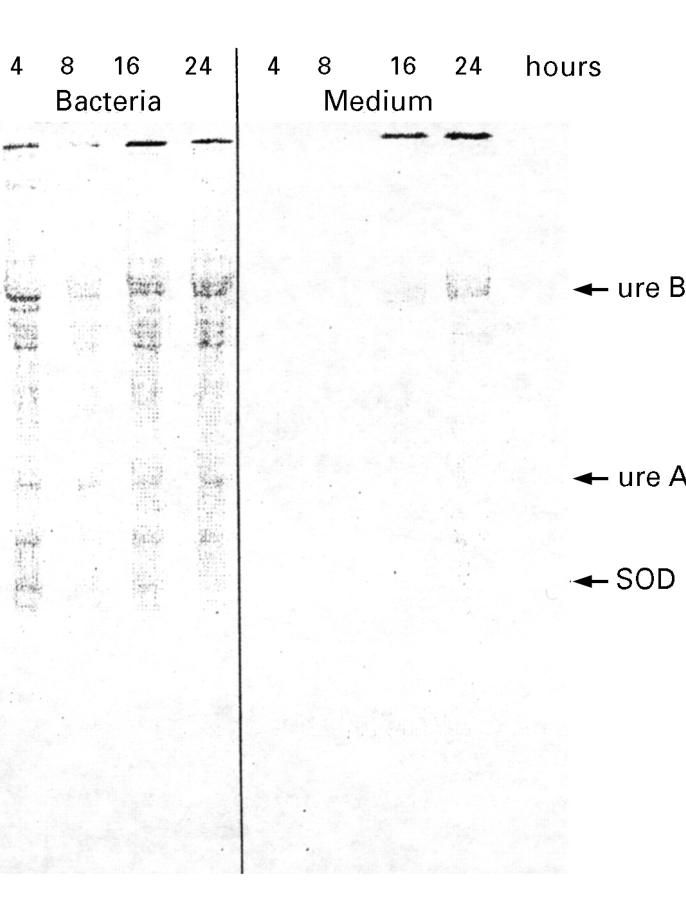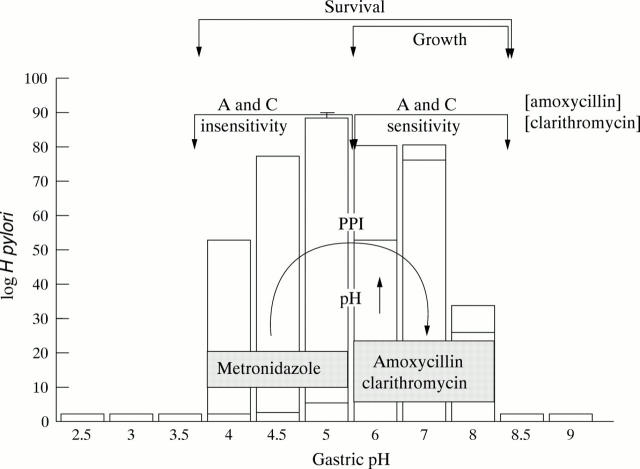Full Text
The Full Text of this article is available as a PDF (124.1 KB).
Figure 1 .
Comparison of the pH optimum of urease external to H pylori and urease in intact organisms illustrating the 10-fold activation in intact organisms seen between pH 6.5 and 5.5.
Figure 2 .
Comparison of protein labelling as a function of time using 35S-methionine to label the protein. The four lanes on the right represent proteins synthesised in intact H pylori and the four lanes on the left the medium in which these were suspended. Significant quantities of labelled protein only appear in the medium after about 16 hours of incubation. The protein in the medium shows the same relative labelling pattern as in the whole bacteria. This image is typical of at least three experiments. SOD, superoxide dismutase.
Figure 3 .
Comparison of the pH range over which H pylori survives to the pH range at which it grows or synthesises protein in the absence of urea. On the figure we indicate the range for which antibiotic sensitivity is expected and illustrate the theoretical effect of proton pump inhibition (PPI) on the population distribution of H pylori between dividing and non-dividing organisms. A, amoxycillin; C, clarithromycin.
Selected References
These references are in PubMed. This may not be the complete list of references from this article.
- Axon A. T. Eradication of Helicobacter pylori. Scand J Gastroenterol Suppl. 1996;214:47–60. [PubMed] [Google Scholar]
- Clyne M., Labigne A., Drumm B. Helicobacter pylori requires an acidic environment to survive in the presence of urea. Infect Immun. 1995 May;63(5):1669–1673. doi: 10.1128/iai.63.5.1669-1673.1995. [DOI] [PMC free article] [PubMed] [Google Scholar]
- Dunn B. E., Vakil N. B., Schneider B. G., Miller M. M., Zitzer J. B., Peutz T., Phadnis S. H. Localization of Helicobacter pylori urease and heat shock protein in human gastric biopsies. Infect Immun. 1997 Apr;65(4):1181–1188. doi: 10.1128/iai.65.4.1181-1188.1997. [DOI] [PMC free article] [PubMed] [Google Scholar]
- Flejou J. F., Bahame P., Smith A. C., Stockbrugger R. W., Rode J., Price A. B. Pernicious anaemia and Campylobacter like organisms; is the gastric antrum resistant to colonisation? Gut. 1989 Jan;30(1):60–64. doi: 10.1136/gut.30.1.60. [DOI] [PMC free article] [PubMed] [Google Scholar]
- Hawtin P. R., Stacey A. R., Newell D. G. Investigation of the structure and localization of the urease of Helicobacter pylori using monoclonal antibodies. J Gen Microbiol. 1990 Oct;136(10):1995–2000. doi: 10.1099/00221287-136-10-1995. [DOI] [PubMed] [Google Scholar]
- Katzka D. A., Paoletti V., Leite L., Castell D. O. Prolonged ambulatory pH monitoring in patients with persistent gastroesophageal reflux disease symptoms: testing while on therapy identifies the need for more aggressive anti-reflux therapy. Am J Gastroenterol. 1996 Oct;91(10):2110–2113. [PubMed] [Google Scholar]
- Lind T., Cederberg C., Ekenved G., Haglund U., Olbe L. Effect of omeprazole--a gastric proton pump inhibitor--on pentagastrin stimulated acid secretion in man. Gut. 1983 Apr;24(4):270–276. doi: 10.1136/gut.24.4.270. [DOI] [PMC free article] [PubMed] [Google Scholar]
- Logan R. P., Walker M. M., Misiewicz J. J., Gummett P. A., Karim Q. N., Baron J. H. Changes in the intragastric distribution of Helicobacter pylori during treatment with omeprazole. Gut. 1995 Jan;36(1):12–16. doi: 10.1136/gut.36.1.12. [DOI] [PMC free article] [PubMed] [Google Scholar]
- Meyer-Rosberg K., Scott D. R., Rex D., Melchers K., Sachs G. The effect of environmental pH on the proton motive force of Helicobacter pylori. Gastroenterology. 1996 Oct;111(4):886–900. doi: 10.1016/s0016-5085(96)70056-2. [DOI] [PubMed] [Google Scholar]
- Mitchell P. Chemiosmotic coupling in oxidative and photosynthetic phosphorylation. Biol Rev Camb Philos Soc. 1966 Aug;41(3):445–502. doi: 10.1111/j.1469-185x.1966.tb01501.x. [DOI] [PubMed] [Google Scholar]
- Mobley H. L., Island M. D., Hausinger R. P. Molecular biology of microbial ureases. Microbiol Rev. 1995 Sep;59(3):451–480. doi: 10.1128/mr.59.3.451-480.1995. [DOI] [PMC free article] [PubMed] [Google Scholar]
- Phadnis S. H., Parlow M. H., Levy M., Ilver D., Caulkins C. M., Connors J. B., Dunn B. E. Surface localization of Helicobacter pylori urease and a heat shock protein homolog requires bacterial autolysis. Infect Immun. 1996 Mar;64(3):905–912. doi: 10.1128/iai.64.3.905-912.1996. [DOI] [PMC free article] [PubMed] [Google Scholar]
- Schade C., Flemström G., Holm L. Hydrogen ion concentration in the mucus layer on top of acid-stimulated and -inhibited rat gastric mucosa. Gastroenterology. 1994 Jul;107(1):180–188. doi: 10.1016/0016-5085(94)90075-2. [DOI] [PubMed] [Google Scholar]
- Scott D. R., Weeks D., Hong C., Postius S., Melchers K., Sachs G. The role of internal urease in acid resistance of Helicobacter pylori. Gastroenterology. 1998 Jan;114(1):58–70. doi: 10.1016/s0016-5085(98)70633-x. [DOI] [PubMed] [Google Scholar]
- Tomb J. F., White O., Kerlavage A. R., Clayton R. A., Sutton G. G., Fleischmann R. D., Ketchum K. A., Klenk H. P., Gill S., Dougherty B. A. The complete genome sequence of the gastric pathogen Helicobacter pylori. Nature. 1997 Aug 7;388(6642):539–547. doi: 10.1038/41483. [DOI] [PubMed] [Google Scholar]





